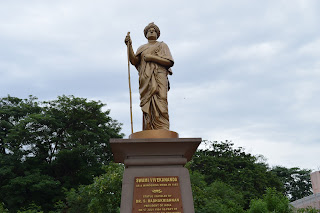There is a house next to the Parthasarathy Temple at Triplicane which has, by a rough estimate, about 500,000 people pass through it on an annual basis. Actually, most of them go through the front room of the house during the ther (chariot) festival at the temple, because the idol of the deity is taken through this house in to the chariot. While it was once a thatch roof, the front of the house is now properly covered with a concrete roof, thus protecting the devotees much better than before.
This house has not only been associated with religion, but also with the fervour of the freedom struggle. It pre-dates the formation of the Indian National Congress; the house was built in 1877, 8 years before the Congress was founded. The house was built by Thirumalacharya, a descendant of one of the Pradhans of the Mysore Wodeyars. Thirumalacharya was a vakil and probably in that capacity had become close to the Nawab of the Carnatic. The Nawab gifted a set of six carved pillars that even today frame the main corridor of this house.
Thirumalacharya's son was a fan of the Buddha and at his insistence, the house was named Gautamashrama. This plaque in the covered front room of the house is a much later addition, dating to 1984. It proudly proclaims that this is a 'hallowed house', having hosted luminaries like Vivekananda, Bal Gangadhar Tilak, Mahatma Gandhi, Bipin Chandra Pal, as also many others who lived closer to Madras, such as V.O.Chidambaram Pillai, Subramaniam Siva and Subramania Bharati who lived but a few streets away, Sadly, this house is emptied of its good folk - the current generation has mostly moved away from Triplicane - and may soon be just a page in the book of history!

































